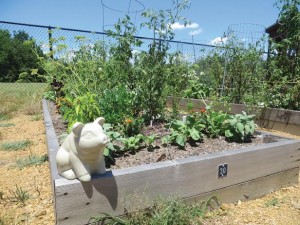
Mountain View College is making great inroads in the sustainability and slow foods movement in an area known for fast food joints. (Photo courtesy Mountain View College)
By Laurie Wiegler
There was a time in 1980s San Francisco, when a reporter could let an apartment from a woman out in the Sunset District and be surprised that there was a garden out back, a patch of land sprouting carrots, lettuce, beets, and luscious tomatoes.
Today, gardens are everywhere seemingly, even as water shortages, zero lots and high-density housing curtail gardening plans. Communities are filling in the gaps, though, and shared gardens are blossoming.
Whether one talks to a university garden manager in Dallas, an urban gardener in New Haven, or a 79-year-old community garden coordinator in New Hampshire, one thing’s clear: the shared garden movement has grown beyond just ‘tree-huggers’ and into the community at large. Kitchen gardens preceded the modern supermarket, and now we’re turning back the clock to reap greater health benefits and social nourishment.
Everything’s Bigger in Texas
The adage is true: everything really is bigger here, and that can include fruits and vegetables.
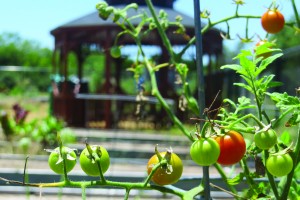
Tomatoes in Texas? Yes, the Lone Star State needs fresh vegetables far more than it needs another burger stand. Though come to think of it, these would be right at home on a burger. (Photo courtesy Mountain View College)
Lori De La Cruz, garden manager at Dallas’ Mountain View College Slow Community Food Garden, lists cantaloupe, tomatoes, squash, green beans, lettuce and Swiss chard, among other organic delectables that they grow seasonally.
MVC also has an aquaponics lab where goldfish and koi provide nutrients needed to grow crops such as spinach, bok choy and parsley in a closed loop system; the lab is used as a training tool for students.
The community garden contains 40 raised beds, each approximately four feet wide by 15 feet long. Half the beds have been leased, and she’s reaching out to the community to lease the rest, she says of the project that was funded by Wells Fargo with an Environmental Solutions for Communities grant in the amount of $28,824.00 in August of 2014.
Some of the plots are used for staff teaching purposes. “Two are set aside for professors to use specifically [for] biology and nutrition [courses], and we’ve also donated a bin to Early College High School, so their science team could do experiments in their basement,” De La Cruz says.
Other plots are used for mulch storage, with the rest, about half, allocated for anyone who wants one in the community. De La Cruz says that of this latter group, more work needs to be done through outreach. “There aren’t as many community participants as I’d like.”
One of the challenges is always the fickle weather of the region, from the extreme drought of a couple years ago to the record floods of late. Yet, it’s not a hindrance to their spirit, and De La Cruz fully intends to lease all the plots, at the cheap rate of $50 a year, before too long.
Plots Thicken in New Hampshire
Walpole Community Garden and Orchard in Walpole, New Hampshire is run by Fritze Till, an eponymously named woman if ever there was one. She laughs, and says this really is her last name. What’s even more striking about Till, though, is that at nearly 80 she not only looks like a vivacious Helen Mirren but is still gardening up a storm. “This is our seventh growing season. We have 28 members from ages 10 to 80,” she enthuses.
Walpole is close to an acre, she says, a literal outgrowth of the town’s energy committee in 2008. Seven years later, it’s a hit. “People can have one plot or eight plots depending on their need,” she says.
Each plot is three to four-feet wide, and vary in length; some are 15 feet long. Spaces in between allow one to “reach from either side so you don’t have to compact the soil,” says Till. “This is important when we are talking about nutrient pathways.”
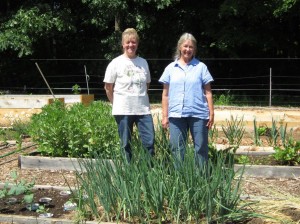
Celeste Longacre, an author and gardener, with friend Fritze Till, who is in charge of the community garden.
The garden is spotlighted in her friend Celeste Longacre’s book, Celeste’s Garden Delights: Discover The Many Ways A Garden Can Nurture You (p. 126) which includes interviews with others known for promoting organic foods, and touts how to grow, can, ferment, freeze and dry fresh produce in a root cellar. Longacre, a longtime Farmer’s Almanac contributor is also a former gardener at Walpole.
Till promotes the presence of bees, anthropods like worms, and decomposers already in the soil to offer aeration and food to the plants, a natural cycle that is critical to thrive.
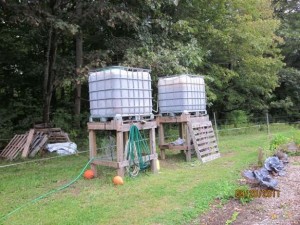
“Water Tanks provide a nutrient rich gravity flow to garden plots,” says Fritz Tille, the gardening maven at Walpole Community Garden in New Hampshire. (Photo courtesy Fritze Till)
She says theirs is the only non-till community garden in the state, and employs the “lasagna” method of gardening, meaning that “we don’t dig. We build soil up. When we started it was a pasture that had been neglected so we laid down cardboard, then layers of organic materials, hay, grass clippings and manure. That’s unique in itself.”
Fifteen to 20 percent of Walpole’s output is funneled to the Fall Mountain Food Shelf, a regional food bank, as well as a senior housing complex in town.
Hoeing Rows on William Street
William Street Community Garden, within walking distance of Yale University in New Haven, Conn., is smaller than some of the community gardens in the country, but the love and dedication to maintain it are just as significant. This reporter enjoyed living next door a few years ago, just by happenstance.
Senior gardener, Cordalie Benoit says that in the late ‘90s when they first started it, it was only for people on William Street. “I moved to New Haven in 2001, and walking around the neighborhood, discovered the garden,” she recalls. She joined shortly thereafter.
Once the garden was open to residents outside of William Street, it doubled in size. The 30 beds, which are raised like the preceding gardens’, are about four by eight feet or five by 10 in size and have been replaced once, says Benoit.
There’s even a wait list to join the $25/year garden, whose coordinator won’t even press for the fee if someone’s unable to manage it, Benoit says.
Part of the New Haven Land Trust gardens peppered around the county, William Street is unique in that it really did inspire redevelopment on the street.
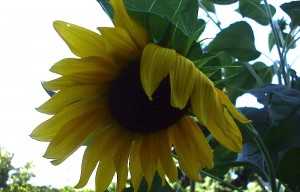
Sunflowers grace this glorious garden on William Street, which has helped revitalized the area. (Photo courtesy Laurie Wiegler)
Benoit says that when she first moved to the area, the street was really run down.
“It was strictly started as a community garden for the community when buildings on William Street were boarded up. There was a lot [here on the street that] was full of trash,” says Benoit. “One woman who started [the garden] tells a story of crying because she could only afford to live on a street with redevelopment.”
These days, William Street Garden, with its abundance of chiv (“a sour green to make soup out of”), collards, kale, dill and strawberries – as well as marigolds and stunning sunflowers that somehow survived Hurricane Irene in 2011 – is a boon to its members.
The community garden was a driver in revitalizing, which to Benoit is an obvious connection. “When you have a vacant lot full of trash it attracts all kinds of negative energies,” she points out.
When you have a place where good things grow and everyone reaps the benefit, that’s a whole other story.
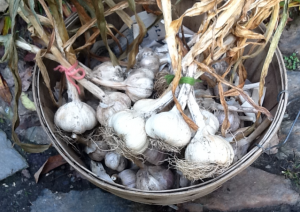
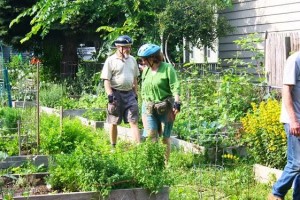
Leave a Reply